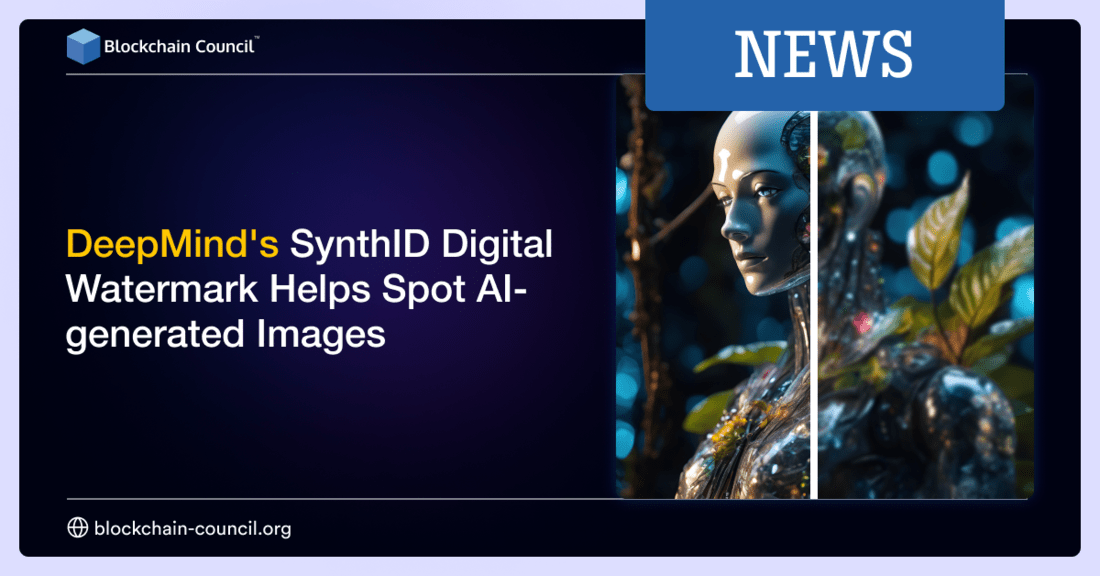
- Blockchain Council
- September 08, 2023
In the ever-evolving landscape of artificial intelligence (AI), where distinguishing between genuine and AI-generated content has become a formidable challenge, DeepMind, Google’s AI research arm, has unveiled a groundbreaking solution – SynthID. This revolutionary digital watermark technology is poised to transform the way we verify images, making it an invaluable tool in the fight against disinformation.
As DeepMind’s head of research, Pushmeet Kohli, succinctly put it, “You can change the color, you can change the contrast, you can even resize it… and DeepMind will still be able to see that it is AI-generated.” SynthID’s capabilities are nothing short of remarkable, offering a level of detection that surpasses traditional watermarking techniques.
The rise of AI-generated images has ushered in a new era of content creation and manipulation. Tools like Midjourney, boasting over 14.5 million users, have made it effortless for individuals to produce images by simply providing text instructions. While these tools have unlocked creative potential, they have also raised pressing concerns about copyright infringement and content ownership on a global scale.
To address these issues, Google has developed its own image generator, Imagen. SynthID, however, will specifically target images created using Imagen, showcasing Google’s commitment to responsible AI usage.
Unlike traditional watermarks, which are often placed conspicuously on images, SynthID operates by subtly modifying individual pixels within an image. This alteration is imperceptible to the human eye but remains detectable by computer algorithms. This approach ensures that the watermark remains intact, even when images are cropped, edited, or subjected to various transformations.
Pushmeet Kohli further emphasized that SynthID represents an “experimental launch” of the technology. Real-world usage will be vital in assessing its robustness and effectiveness in different scenarios. This commitment to refinement underscores Google’s dedication to providing advanced tools for the identification of AI-generated content.
In July, Google, along with six other leading AI companies in the United States, signed a voluntary agreement to implement watermarks, allowing the identification of AI-generated images. While this demonstrates a collective commitment to responsible AI development, Claire Leibowicz of the Partnership on AI believes that standardization and coordination among businesses are essential for effective implementation.
The broader AI industry also recognizes the importance of watermarking. Microsoft and Amazon, giants in the tech world, have pledged to watermark some AI-generated content, aligning with Google’s efforts to promote transparency.
Meta, formerly known as Facebook, has ventured into the domain of video generation with Make-A-Video. The company has stated its intention to add watermarks to generated videos, further addressing the demand for transparency in AI-generated works.
China has taken a stringent approach to AI-generated images by banning them altogether without watermarks. Companies like Alibaba have embraced this policy, applying watermarks to creations made using their cloud division’s text-to-image tool, Tongyi Wanxiang.
SynthID is not just a watermark; it represents a significant step towards empowering users and organizations to work responsibly with AI-generated content. It embeds an imperceptible digital watermark directly into the pixels of an image, preserving image quality and making it compatible with various lossy compression schemes commonly used for JPEGs.
The technology employs two deep learning models—one for watermarking and another for identification—that have been trained on a diverse set of images. This combined model optimizes for multiple objectives, including correctly identifying watermarked content and ensuring imperceptibility by aligning the watermark with the original content.
SynthID offers Vertex AI customers the ability to create AI-generated images responsibly and identify them with confidence. While it may not be impervious to all image manipulations, internal testing has shown that it performs accurately against many common alterations.
This tool provides three confidence levels for interpreting watermark identification results. If a digital watermark is detected, part of the image is likely generated by Imagen. Moreover, SynthID complements existing methods of content identification, making it a versatile addition to the toolkit for addressing the challenges of AI-generated content.
As AI technologies continue to advance and expand across various media, SynthID’s potential applications extend beyond images. Google Cloud, as the first cloud provider to offer such a tool, is firmly committed to developing and deploying responsible AI.
SynthID’s creators envision its integration with other AI models and modalities, including audio, video, and text. This expansion aligns with Google’s commitment to providing advanced tools and fostering trust between creators and users in the digital realm.
SynthID’s creators are excited about the prospect of integrating it into more Google products and making it available to third parties in the near future. This vision reflects Google’s dedication to enabling individuals and organizations to responsibly engage with AI-generated content.
DeepMind’s SynthID represents a significant leap forward in the ongoing quest for transparency and accountability in the age of AI-generated content. Its imperceptible watermarking technology, capable of withstanding image alterations, has the potential to become an industry standard.
As the AI landscape continues to evolve, SynthID’s role in empowering users and organizations to navigate this new era responsibly cannot be overstated. The technology’s robustness and versatility position it as a crucial tool for addressing the challenges of AI-generated content. In the coming years, we can expect to see SynthID’s influence extend across various media, ushering in a new era of image verification and trust in the digital world.


































































 Guides
Guides News
News Blockchain
Blockchain Cryptocurrency
& Digital Assets
Cryptocurrency
& Digital Assets Web3
Web3 Metaverse & NFTs
Metaverse & NFTs
